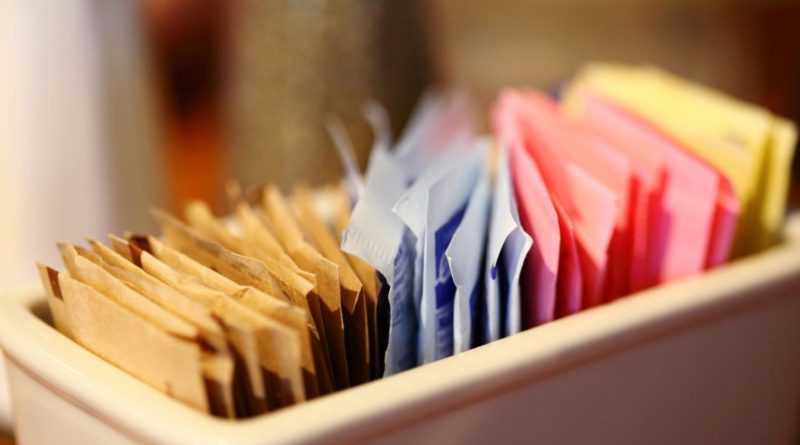DIABETES: 7 Best sweeteners for people with diabetes
What are the best sweeteners for people with diabetes?

People with diabetes must take special care to avoid blood sugar spikes. Controlling blood sugar is important for avoiding the more severe complications of diabetes, including nerve damage and cardiovascular disease.
Choosing alternative sweeteners is one way of maintaining sweetness in food and drink. However, not all alternative sweeteners are good options for people with diabetes. Agave syrup, for example, provides more calories than table sugar.
In this article, we look at seven of the best low-calorie sweeteners for people with diabetes.
–THIS SPACE BELOW IS RESERVE FOR YOUR ADVERTISEMENT –

1. Stevia

Stevia is a popular alternative to sugar.
Stevia is a natural sweetener that comes from the Stevia rebaudianaplant.
To make stevia, manufacturers extract chemical compounds called steviol glycosides from the leaves of the plant.
This highly-processed and purified product is around 300 times sweeter than sucrose, or table sugar, and it is available under different brand names, including Truvia, SweetLeaf, and Sun Crystals.
Stevia has several pros and cons that people with diabetes will need to weigh up. This sweetener is calorie-free and does not raise blood sugar levels. However, it is often more expensive than other sugar substitutes on the market.
Stevia also has a bitter aftertaste that many people may find unpleasant. For this reason, some manufacturers add other sugars and ingredients to balance the taste. This can reduce the nutritional benefit of pure stevia.
Some people report nausea, bloating, and stomach upset after consuming stevia.
The United States Food and Drug Administration (FDA) classify sweeteners made from high-purity steviol glycosides to be “generally recognized as safe,” or GRAS. However, they do not consider stevia leaf or crude stevia extracts to be safe. It is illegal to sell them or import them into the U.S.
According to the FDA, the acceptable daily intake (ADI) of stevia is 4 milligrams per kilogram (mg/kg) of a person’s body weight. Accordingly, a person who weighs 60 kg, or 132 pounds (lb), can safely consume 9 packets of the tabletop sweetener version of stevia.
Various stevia products are available to purchase online.
–THIS SPACE BELOW IS RESERVE FOR YOUR ADVERTISEMENT –

2. Tagatose
Tagatose is a form of fructose that is around 90 percent sweeter than sucrose.
Although it is rare, some fruits, such as apples, oranges, and pineapples, naturally provide tagatose. Manufacturers use tagatose in foods as a low-calorie sweetener, texturizer, and stabilizer.
Not only do the FDA class tagatose as GRAS, but scientists are interested in its potential to help manage type 2 diabetes.
Some studies indicate that tagatose has a low glycemic index (GI) and may support the treatment of obesity. GI is a ranking system that measures the speed at which a type of food increases a person’s blood sugar levels.
Tagatose may be particularly beneficial for people with diabetes who are following a low-GI diet. However, this sugar substitute is more expensive than other low-calorie sweeteners and may be harder to find in stores.
Tagatose products are available to purchase online.
–THIS SPACE BELOW IS RESERVE FOR YOUR ADVERTISEMENT –

3. Sucralose

People can use sucralose instead of sugar when baking.
Sucralose, available under the brand name Splenda, is an artificial sweetener made from sucrose.
This sweetener is about 600 timessweeter than table sugar but contains very few calories.
Sucralose is one of the most popular artificial sweeteners, and it is widely available. Manufacturers add it to a range of products from chewing gum to baked goods.
This alternative sweetener is heat-stable, whereas many other artificial sweeteners lose their flavor at high temperatures. This makes sucralose a popular choice for sugar-free baking and sweetening hot drinks.
The FDA have approved sucralose as a general-purpose sweetener and set an ADI of 5 mg/kg of body weight. A person weighing 60 kg, or 132 lb, can safely consume 23 packets of a tabletop sweetener version of sucralose in a day.
However, recent studies have raised some health concerns. A 2016 studyfound that male mice that consumed sucralose were more likely to develop malignant tumors. The researchers note that more studies are necessary to confirm the safety of sucralose.
A range of sucralose products is available to purchase online.
–THIS SPACE BELOW IS RESERVE FOR YOUR ADVERTISEMENT –

4. Aspartame
Aspartame is a very common artificial sweetener that has been available in the U.S. since the 1980s.
It is around 200 times sweeter than sugar, and manufacturers add it to a wide variety of food products, including diet soda. Aspartame is available in grocery stores under the brand names Nutrasweet and Equal.
Unlike sucralose, aspartame is not a good sugar substitute for baking. Aspartame breaks down at high temperatures, so people generally only use it as a tabletop sweetener.
Aspartame is also not safe for people with a rare genetic disorder known as phenylketonuria.
The FDA consider aspartame to be safe at an ADI of 50 mg/kg of body weight. Therefore, a person who weighs 60 kg, or 132 lb, could consume 75 packets of aspartame in the form of a tabletop sweetener.
Many different aspartame products are available to purchase online.
Here, learn more about the side effects of aspartame.
–THIS SPACE BELOW IS RESERVE FOR YOUR ADVERTISEMENT –

5. Acesulfame potassium
Acesulfame potassium, also known as acesulfame K and Ace-K, is an artificial sweetener that is around 200 times sweeter than sugar.
Manufacturers often combine acesulfame potassium with other sweeteners to combat its bitter aftertaste. It is available under the brand names Sunett and Sweet One.
The FDA have approved acesulfame potassium as a low-calorie sweetener and state that the results of more than 90 studies support its safety.
They have set an ADI for acesulfame potassium of 15 mg/kg of body weight. This is equivalent to a 60 kg, or 132 lb, person consuming 23 packets of a tabletop sweetener version of acesulfame potassium.
A 2017 study in mice has suggested a possible association between acesulfame potassium and weight gain, but further research in humans is necessary to confirm this link.
–THIS SPACE BELOW IS RESERVE FOR YOUR ADVERTISEMENT –

6. Saccharin

Cafes and restaurants may provide saccharin sweeteners.
Saccharin is another widely available artificial sweetener.
There are several different brands of saccharin, including Sweet Twin, Sweet’N Low, and Necta Sweet. Saccharin is a zero-calorie sweetener that is 200–700 times sweeter than table sugar.
According to the FDA, there were safety concerns in the 1970s after research found a link between saccharin and bladder cancer in laboratory rats.
However, more than 30 human studies now support the safety of saccharin, and the National Institutes of Health no longer consider this sweetener to have the potential to cause cancer.
The FDA have determined the ADI of saccharin to be 15 mg/kg of body weight, which means that a 60 kg, or 132 lb, person can consume 45 packets of a tabletop sweetener version of it.
People can purchase a range of saccharin products online.
–THIS SPACE BELOW IS RESERVE FOR YOUR ADVERTISEMENT –

7. Neotame
Neotame is a low-calorie artificial sweetener that is about 7,000–13,000 timessweeter than table sugar. This sweetener can tolerate high temperatures, making it suitable for baking. It is available under the brand name Newtame.
The FDA approved neotame in 2002 as a general-purpose sweetener and flavor enhancer for all foods except for meat and poultry. They state that more than 113 animal and human studies support the safety of neotame and have set an ADI for neotame of 0.3 mg/kg of body weight.
This is equivalent to a 60-kg, or 132-lb, person consuming 23 packets of a tabletop sweetener version of neotame.
–THIS SPACE BELOW IS RESERVE FOR YOUR ADVERTISEMENT –


Considerations
When choosing a low-calorie sweetener, some general considerations include:
- Intended use. Many sugar substitutes do not withstand high temperatures, so they would make poor choices for baking.
- Cost. Some sugar substitutes are expensive, whereas others have a cost closer to that of table sugar.
- Availability. Some sugar substitutes are easier to find in stores than others.
- Taste. Some sugar substitutes, such as stevia, have a bitter aftertaste that many people may find unpleasant. Make sure that the manufacturers have not added chemicals or other sweeteners that reduce the nutritional benefit.
- Natural versus artificial. Some people prefer using natural sweeteners, such as stevia, rather than artificial sugar substitutes. However, natural does not always mean lower-calorie or more healthful.
- Add fruit instead of sweetener: Where possible, add a sweet fruit to a meal instead of sugar or artificial sweeteners. Options include strawberry, blueberry, and mango.
Click here to learn more about managing sugar in the diet.
–THIS SPACE BELOW IS RESERVE FOR YOUR ADVERTISEMENT –


Summary
Many people with diabetes need to avoid or limit sugary foods.
Low-calorie sweeteners can allow those with the condition to enjoy a sweet treat without affecting their blood sugar levels.
Although the FDA generally consider these sugar substitutes to be safe, it is still best to consume them in moderation.
Q:
What are the most naturally sweet foods that do not need sweeteners to add flavor?
A:
The most naturally sweet foods are dates, as well as dried fruits, such as cherries, raisins, apricots and figs.
Fresh fruit, including grapes, bananas, and melon, impart sweet flavor with very little overtly tart or sour flavors. Fresh and dried fruits can be added to a variety of dishes, sauces, smoothies, cereals, and muffins in diced or pureed form.
Unsweetened applesauce is also a suitable option for adding sweetness to yogurt, oatmeal, and bars without adding refined sugar. A person can also reduce plain balsamic vinegar with heat to create a sweet sauce.
Natalie Butler, RD, LDAnswers represent the opinions of our medical experts. All content is strictly informational and should not be considered medical advice.
We picked linked items based on the quality of products, and list the pros and cons of each to help you determine which will work best for you. We partner with some of the companies that sell these products, which means Healthline UK and our partners may receive a portion of revenues if you make a purchase using a link(s) above.
–THIS SPACE BELOW IS RESERVE FOR YOUR ADVERTISEMENT –











